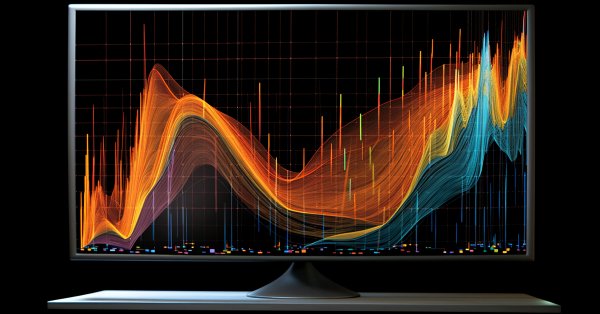
Library for easy and quick development of MetaTrader programs (part XV): Collection of symbol objects
In this article, we will consider creation of a symbol collection based on the abstract symbol object developed in the previous article. The abstract symbol descendants are to clarify a symbol data and define the availability of the basic symbol object properties in a program. Such symbol objects are to be distinguished by their affiliation with groups.


Universal Trend with the Graphical Interface
In this article a universal trend indicator is created based on a number of standard indicators. An additionally created graphical interface allows selecting the type of indicator and adjusting its parameter. The indicator is displayed in a separate window with rows of colored icons.

3D Modeling in MQL5
A time series is a dynamic system, in which values of a random variable are received continuously or at successive equally spaced points in time. Transition from 2D to 3D market analysis provides a new look at complex processes and research objects. The article describes visualization methods providing 3D representation of two-dimensional data.


A DLL-free solution to communicate between MetaTrader 5 terminals using Named Pipes
The article describes how to implement Interprocess Communication between MetaTrader 5 client terminals using named pipes. For the use of the named pipes, the CNamedPipes class is developed. For the test of its use and to measure the connection throughput, the tick indicator, the server and client scripts are presented. The use of named pipes is sufficient for real-time quotes.

Thomas DeMark's Sequential (TD SEQUENTIAL) using artificial intelligence
In this article, I will tell you how to successfully trade by merging a very well-known strategy and a neural network. It will be about the Thomas DeMark's Sequential strategy with the use of an artificial intelligence system. Only the first part of the strategy will be applied, using the Setup and Intersection signals.

Graphics in DoEasy library (Part 88): Graphical object collection — two-dimensional dynamic array for storing dynamically changing object properties
In this article, I will create a dynamic multidimensional array class with the ability to change the amount of data in any dimension. Based on the created class, I will create a two-dimensional dynamic array to store some dynamically changed properties of graphical objects.

MQL5 Cookbook: Getting Position Properties
In this article, we will create a script that gets all position properties and displays them to the user in a dialog box. Upon running the script, you will be able to select out of two modes available in the drop-down list in the external parameters: to either view position properties only on the current symbol or to view position properties on all symbols.


Price velocity measurement methods
There are multiple different approaches to market research and analysis. The main ones are technical and fundamental. In technical analysis, traders collect, process and analyze numerical data and parameters related to the market, including prices, volumes, etc. In fundamental analysis, traders analyze events and news affecting the markets directly or indirectly. The article deals with price velocity measurement methods and studies trading strategies based on that methods.


MQL5 Cookbook: Trading strategy stress testing using custom symbols
The article considers an approach to stress testing of a trading strategy using custom symbols. A custom symbol class is created for this purpose. This class is used to receive tick data from third-party sources, as well as to change symbol properties. Based on the results of the work done, we will consider several options for changing trading conditions, under which a trading strategy is being tested.

Library for easy and quick development of MetaTrader programs (part XX): Creating and storing program resources
The article deals with storing data in the program's source code and creating audio and graphical files out of them. When developing an application, we often need audio and images. The MQL language features several methods of using such data.

Change Expert Advisor Parameters From the User Panel "On the Fly"
This article provides a small example demonstrating the implementation of an Expert Advisor whose parameters can be controlled from the user panel. When changing the parameters "on the fly", the Expert Advisor writes the values obtained from the info panel to a file to further read them from the file and display accordingly on the panel. This article may be relevant to those who trade manually or in semi-automatic mode.

Library for easy and quick development of MetaTrader programs (part XXXII): Pending trading requests - placing orders under certain conditions
We continue the development of the functionality allowing users to trade using pending requests. In this article, we are going to implement the ability to place pending orders under certain conditions.

Developing the oscillator-based ZigZag indicator. Example of executing a requirements specification
The article demonstrates the development of the ZigZag indicator in accordance with one of the sample specifications described in the article "How to prepare Requirements Specification when ordering an indicator". The indicator is built by extreme values defined using an oscillator. There is an ability to use one of five oscillators: WPR, CCI, Chaikin, RSI or Stochastic Oscillator.


How to Write an Indicator on the Basis of Another Indicator
In MQL5 you can write an indicator both from a scratch and on the basis of another already existing indicator, in-built in the client terminal or a custom one. And here you also have two ways - to improve an indicator by adding new calculations and graphical styles to it , or to use an indicator in-built in the client terminal or a custom one via the iCustom() or IndicatorCreate() functions.

Indicator for Point and Figure Charting
There are lots of chart types that provide information on the current market situation. Many of them, such as Point and Figure chart, are the legacy of the remote past. The article describes an example of Point and Figure charting using a real time indicator.

Library for easy and quick development of MetaTrader programs (part XXIX): Pending trading requests - request object classes
In the previous articles, we checked the concept of pending trading requests. A pending request is, in fact, a common trading order executed by a certain condition. In this article, we are going to create full-fledged classes of pending request objects — a base request object and its descendants.

An attempt at developing an EA constructor
In this article, I offer my set of trading functions in the form of a ready-made EA. This method allows getting multiple trading strategies by simply adding indicators and changing inputs.


Moving Mini-Max: a New Indicator for Technical Analysis and Its Implementation in MQL5
In the following article I am describing a process of implementing Moving Mini-Max indicator based on a paper by Z.G.Silagadze 'Moving Mini-max: a new indicator for technical analysis'. The idea of the indicator is based on simulation of quantum tunneling phenomena, proposed by G. Gamov in the theory of alpha decay.


Universal RSI indicator for working in two directions simultaneously
When developing trading algorithms, we often encounter a problem: how to determine where a trend/flat begins and ends? In this article, we try to create a universal indicator, in which we try to combine signals for different types of strategies. We will try to simplify the process of obtaining trade signals in an expert as much as possible. An example of combining several indicators in one will be given.


Better Programmer (Part 07): Notes on becoming a successful freelance developer
Do you wish to become a successful Freelance developer on MQL5? If the answer is yes, this article is right for you.


Applying One Indicator to Another
When writing an indicator that uses the short form of the OnCalculate() function call, you might miss the fact that an indicator can be calculated not only by price data, but also by data of some other indicator (no matter whether it is a built-in or custom one). Do you want to improve an indicator for its correct application to the other indicator's data? In this article we'll review all the steps required for such modification.

Library for easy and quick development of MetaTrader programs (part V): Classes and collection of trading events, sending events to the program
In the previous articles, we started creating a large cross-platform library simplifying the development of programs for MetaTrader 5 and MetaTrader 4 platforms. In the fourth part, we tested tracking trading events on the account. In this article, we will develop trading event classes and place them to the event collections. From there, they will be sent to the base object of the Engine library and the control program chart.

Library for easy and quick development of MetaTrader programs (part XXVI): Working with pending trading requests - first implementation (opening positions)
In this article, we are going to store some data in the value of the orders and positions magic number and start the implementation of pending requests. To check the concept, let's create the first test pending request for opening market positions when receiving a server error requiring waiting and sending a repeated request.


MQL5 Cookbook - Pivot trading signals
The article describes the development and implementation of a class for sending signals based on pivots — reversal levels. This class is used to form a strategy applying the Standard Library. Improving the pivot strategy by adding filters is considered.


MQL5 Cookbook - Trading signals of moving channels
The article describes the process of developing and implementing a class for sending signals based on the moving channels. Each of the signal version is followed by a trading strategy with testing results. Classes of the Standard Library are used for creating derived classes.


OpenCL: The Bridge to Parallel Worlds
In late January 2012, the software development company that stands behind the development of MetaTrader 5 announced native support for OpenCL in MQL5. Using an illustrative example, the article sets forth the programming basics in OpenCL in the MQL5 environment and provides a few examples of the naive optimization of the program for the increase of operating speed.


Cross-Platform Expert Advisor: Money Management
This article discusses the implementation of money management method for a cross-platform expert advisor. The money management classes are responsible for the calculation of the lot size to be used for the next trade to be entered by the expert advisor.

Use of Resources in MQL5
MQL5 programs not only automate routine calculations, but also can create a full-featured graphical environment. The functions for creating truly interactive controls are now virtually the same rich, as those in classical programming languages. If you want to write a full-fledged stand-alone program in MQL5, use resources in them. Programs with resources are easier to maintain and distribute.

Continuous Walk-Forward Optimization (Part 4): Optimization Manager (Auto Optimizer)
The main purpose of the article is to describe the mechanism of working with our application and its capabilities. Thus the article can be treated as an instruction on how to use the application. It covers all possible pitfalls and specifics of the application usage.


MQL5 Programming Basics: Lists
The new version of the programming language for trading strategy development, MQL [MQL5], provides more powerful and effective features as compared with the previous version [MQL4]. The advantage essentially lies in the object-oriented programming features. This article looks into the possibility of using complex custom data types, such as nodes and lists. It also provides an example of using lists in practical programming in MQL5.

MQL5 Cookbook: Multi-Currency Expert Advisor - Simple, Neat and Quick Approach
This article will describe an implementation of a simple approach suitable for a multi-currency Expert Advisor. This means that you will be able to set up the Expert Advisor for testing/trading under identical conditions but with different parameters for each symbol. As an example, we will create a pattern for two symbols but in such a way so as to be able to add additional symbols, if necessary, by making small changes to the code.


Using spreadsheets to build trading strategies
The article describes the basic principles and methods that allow you to analyze any strategy using spreadsheets (Excel, Calc, Google). The obtained results are compared with MetaTrader 5 tester.

Visualize this! MQL5 graphics library similar to 'plot' of R language
When studying trading logic, visual representation in the form of graphs is of great importance. A number of programming languages popular among the scientific community (such as R and Python) feature the special 'plot' function used for visualization. It allows drawing lines, point distributions and histograms to visualize patterns. In MQL5, you can do the same using the CGraphics class.


MQL5 vs QLUA - Why trading operations in MQL5 are up to 28 times faster?
Have you ever wondered how quickly your order is delivered to the exchange, how fast it is executed, and how much time your terminal needs in order to receive the operation result? We have prepared a comparison of trading operation execution speed, because no one has ever measured these values using applications in MQL5 and QLUA.


Studying the CCanvas Class. How to Draw Transparent Objects
Do you need more than awkward graphics of moving averages? Do you want to draw something more beautiful than a simple filled rectangle in your terminal? Attractive graphics can be drawn in the terminal. This can be implemented through the CСanvas class, which is used for creating custom graphics. With this class you can implement transparency, blend colors and produce the illusion of transparency by means of overlapping and blending colors.


How to Export Quotes from МetaTrader 5 to .NET Applications Using WCF Services
Want to organize export of quotes from MetaTrader 5 to your own application? The MQL5-DLL junction allows to create such solutions! This article will show you one of the ways to export quotes from MetaTrader 5 to applications written in .NET. For me it was more interesting, rational and easy to implement export of quotes using this very platform. Unfortunately, version 5 still does not support .NET, so like in old days we will use win32 dll with .NET support as an interlayer.

Library for easy and quick development of MetaTrader programs (part XXI): Trading classes - Base cross-platform trading object
In this article, we will start the development of the new library section - trading classes. Besides, we will consider the development of a unified base trading object for MetaTrader 5 and MetaTrader 4 platforms. When sending a request to the server, such a trading object implies that verified and correct trading request parameters are passed to it.

Library for easy and quick development of MetaTrader programs (part XXXI): Pending trading requests - opening positions under certain conditions
Starting with this article, we are going to develop a functionality allowing users to trade using pending requests under certain conditions, for example, when reaching a certain time limit, exceeding a specified profit or closing a position by stop loss.


The Implementation of a Multi-currency Mode in MetaTrader 5
For a long time multi-currency analysis and multi-currency trading has been of interest to people. The opportunity to implement a full fledged multi-currency regime became possible only with the public release of MetaTrader 5 and the MQL5 programming language. In this article we propose a way to analyze and process all incoming ticks for several symbols. As an illustration, let's consider a multi-currency RSI indicator of the USDx dollar index.


Native Twitter Client: Part 2
A Twitter client implemented as MQL class to allow you to send tweets with photos. All you need is to include a single self contained include file and off you go to tweet all your wonderful charts and signals.